Слайд 2 SOLIDARITY AND POLITENESS
Contents
Introduction
Generalizations concerning address systems
Basic

concepts and origin of T/V distinction and address terms
Semantic differences and similarities among
French and German T/V usage
Politeness
Positive realizations of politeness
Negative realizations of politeness
Three politeness systems
Conclusion
Слайд 3
Introduction
The purpose of the present research from a sociolinguistic

stance is to consider the aspects of solidarity and politeness including face-threatening acts from the point of view of their linguistic components, relevance for social interaction and their usage in male/female discourse.
In essence, this research will show that certain linguistic choices a speaker makes indicate the social relationship that the speaker perceives to exist between his or her interlocutor.
Слайд 4Generalizations concerning address systems
Aspects of social relationships, such as distance, solidarity or

intimacy are given linguistic expression by address systems consisting of a T/V distinction and address terms. This way, speakers are given the chance to either be more formal or less formal with their interlocutor on certain occasions (Hickey 2007: 3).
Слайд 5Basic concepts and origin of T/V distinction and address terms
The term address

denotes a speaker’s linguistic reference to his/her interlocutor.
Address means only the main linguistic interaction without opening forms of address.
Speaking of forms of address includes words and phrases that are used for addressing.
These words and phrases refer to the interlocutor and thus contain deictic expressions designating the interlocutors, but not necessarily so, since their lexical meaning can differ from or even contradict the addressee’s characteristics.
Слайд 6Pronoun of Address
Concerning pronouns of address, it has to be mentioned that

pronouns referring to the interlocutors are meant. These pronouns are second person pronouns such as English you, German du and Ihr, French tu and vous
) For convenience sake in order to thus designate a pronoun that either refers to social distance (V) or intimacy (T) in any language (1960: 254).
Слайд 7semantic evolution of the usage of T and V pronouns of address
Considering

the consequence and the semantic evolution of the usage of T and V pronouns of address, it was apparent that by medieval times the upper classes began to use V forms with each other to show “mutual respect and politeness” (Wardhaugh 1992: 259).
Nevertheless, T forms of social intimacy or rather solidarity persisted among the lower classes with the upper classes using T forms only when addressing the lower classes
Слайд 8semantic evolution of the usage of T and V pronouns of address
Contrary

to this, V forms were on the one hand used by the upper classes amongst themselves to show respect or rather politeness and on the other hand V forms were used by the lower classes when addressing the upper classes so that a social distance was established between these classes.
. In referring to Brown and Gilman (1960), Wardhaugh points out at that this T/V usage of upper classes addressing lower ones with T but receiving V forms of respect resulted in a non-reciprocal usage of asymmetrical patterns of address that therefore came to semantically symbolize a ‘power’ relationship such as officer to soldier, priest to penitent or master/mistress to servants (1992: 259
Слайд 9semantic evolution of the usage of T and V pronouns of address
This

power semantic is based upon a strict rule in which the superior says T and the inferior addresses the superior with the V form.
In contrast to this power semantic of the non-reciprocal usage of T/V pronouns of address usage, the reciprocal V usage of symmetrical address terms, that is when both interlocutors independent of class address each other with the V pronoun of address, then this usage of V forms, as Wardhaugh puts it, becomes ‘polite’ usage.
Слайд 10semantic evolution of the usage of T and V pronouns of address
On

the basis of this statement, the V form can be used by both interlocutors to indicate politeness as well as social distance along with the T form now being used by both to show solidarity (Lambert/Tucker 1976: 2).
). But the non-reciprocal T/V usage can still be used to express status differences,
at least in American English when for instance, one person addresses another with a first name and expects a title plus last name in return, for example:
‘Is that you, Max?’ ‘Yes, Mr. Adams.’ (1976: 2).
Слайд 11T/V Usage in English
In English, all kinds of T/V usage or rather

address terms combinations, whether reciprocal or nonreciprocal, are possible: Dr Smith, John Smith, Smith, John, Johnnie, Doc, Sir, Mack and so on, with Dr Smith himself expecting to be addressed Doctor from a patient, Dad from his son, John from his brother, Dear from his wife and Sir from subordinants.
Слайд 12Politeness
In general sense: taking account of sense: feelings of others, making others

feel comfortable.
Linguistically: speaking appropriately to the relationship between speaker and hearer. Linguistic politeness requires understanding how language works in variety of social contexts
Слайд 13Positive and Negative politeness
Positive politeness: solidarity oriented,
politeness: oriented, emphasizes shared attitudes
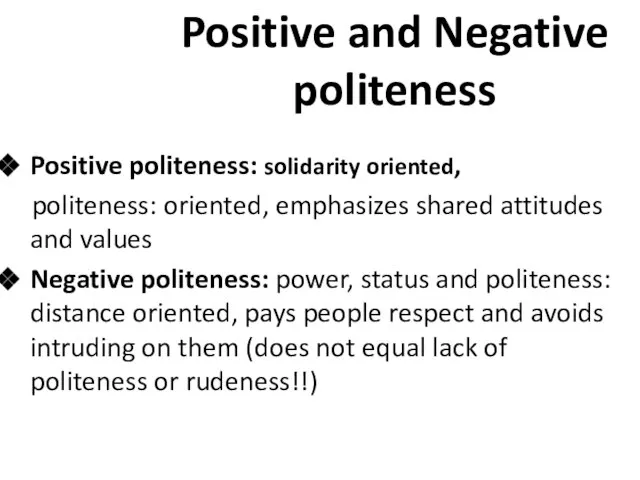
and values
Negative politeness: power, status and politeness: distance oriented, pays people respect and avoids intruding on them (does not equal lack of politeness or rudeness!!)
Слайд 14 Look at the following situations:
A. Paul is in his friend’s house
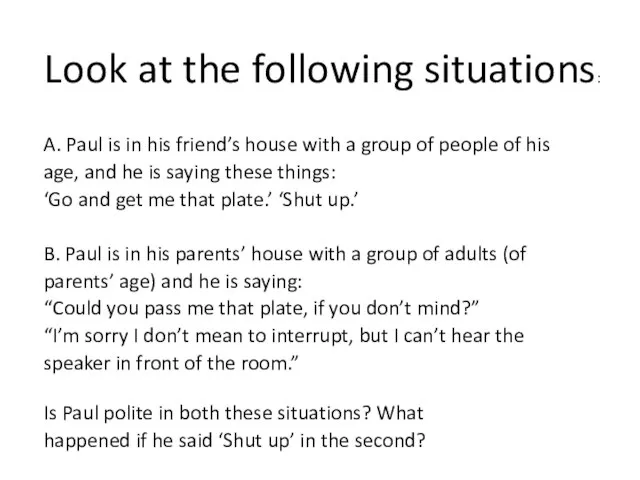
with a group of people of his
age, and he is saying these things:
‘Go and get me that plate.’ ‘Shut up.’
B. Paul is in his parents’ house with a group of adults (of
parents’ age) and he is saying:
“Could you pass me that plate, if you don’t mind?”
“I’m sorry I don’t mean to interrupt, but I can’t hear the
speaker in front of the room.”
Is Paul polite in both these situations? What
happened if he said ‘Shut up’ in the second?
Слайд 15LINGUISTIC POLITENESS
Needs assessing relationship b/w speaker and hearer along two social dimensions:
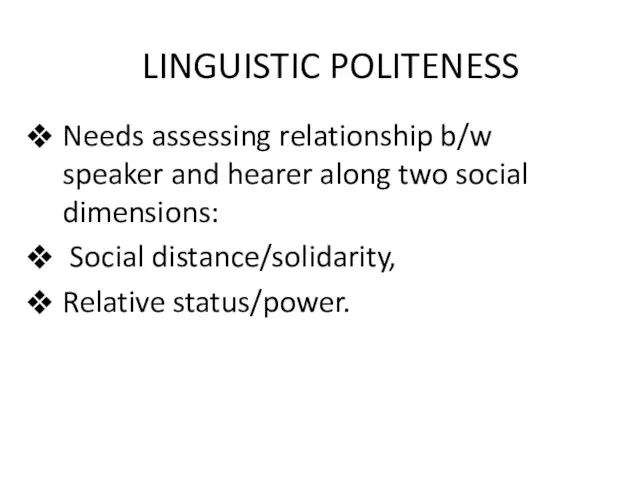
Social distance/solidarity,
Relative status/power.
Слайд 16POWER AND SOLIDARITY
POWER:
a relation between two people, it determines the negative
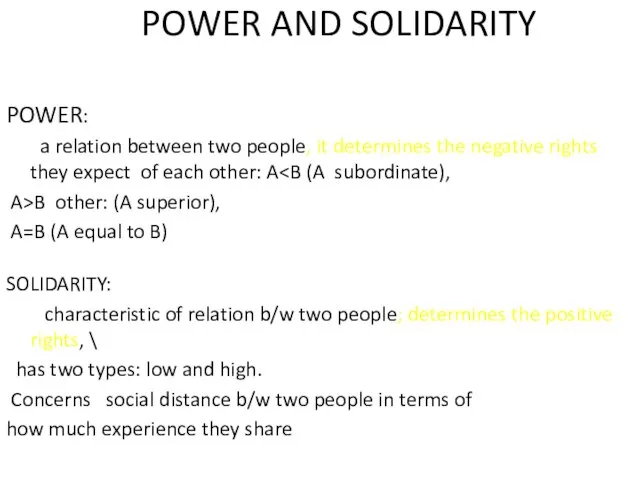
rights they expect of each other: A A>B other: (A superior),
A=B (A equal to B)
SOLIDARITY:
characteristic of relation b/w two people; determines the positive rights, \
has two types: low and high.
Concerns social distance b/w two people in terms of
how much experience they share
Слайд 17FACTORS DETERMINING CHOICE
OF LINGUISTIC ITEMS
Rules of speech community govern linguistic politeness,
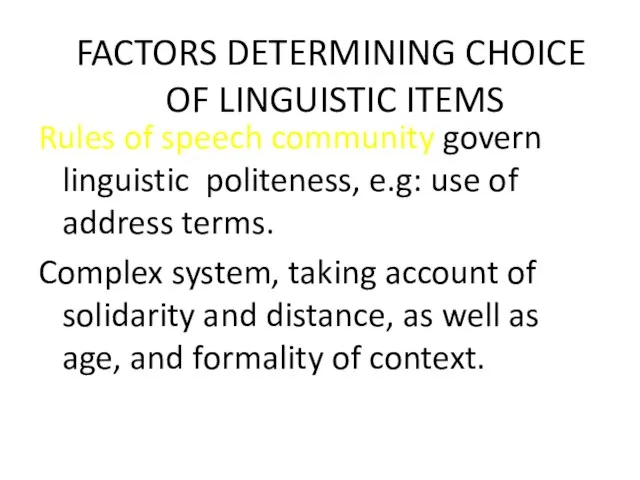
e.g: use of address terms.
Complex system, taking account of solidarity and distance, as well as age, and formality of context.
Слайд 18FACTORS DETERMINING CHOICE
OF LINGUISTIC ITEMS
In the past: power and status differences
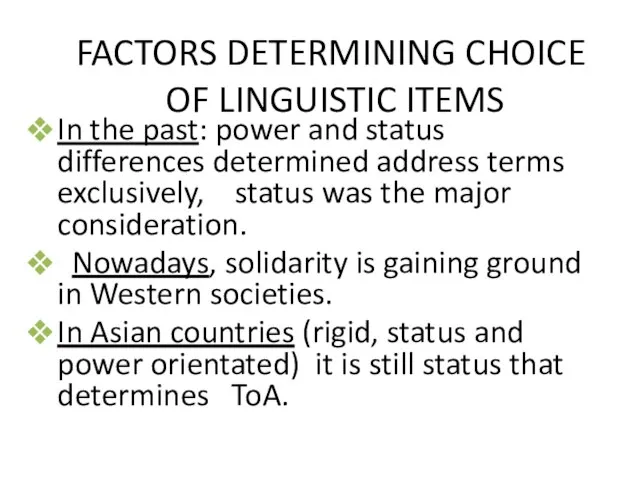
determined address terms exclusively, status was the major consideration.
Nowadays, solidarity is gaining ground in Western societies.
In Asian countries (rigid, status and power orientated) it is still status that determines ToA.
Слайд 19SUMMARY
RELEVANT DIMENSIONS IN ALL SOCIETIES DETERMINING WAYS OF LINGUISTIC POLITENESS:
SOCIAL
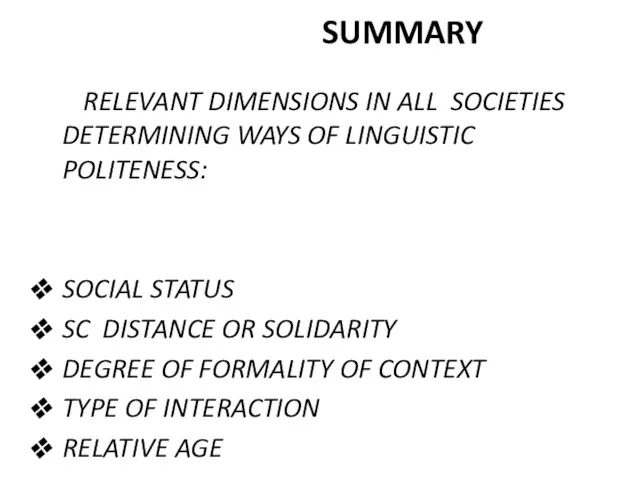
STATUS
SC DISTANCE OR SOLIDARITY
DEGREE OF FORMALITY OF CONTEXT
TYPE OF INTERACTION
RELATIVE AGE


















 Борис Заходер «Вредный кот»
Борис Заходер «Вредный кот» Центральный процессор
Центральный процессор Что такое калибровка?
Что такое калибровка? Model IS-LM
Model IS-LM 1 занятие_Начало
1 занятие_Начало Презентация на тему Увеличиваем, уменьшаем число на 2
Презентация на тему Увеличиваем, уменьшаем число на 2 Макроэкономика Тема 1 Предмет и метод макроэкономики. Основные макроэкономические показатели.
Макроэкономика Тема 1 Предмет и метод макроэкономики. Основные макроэкономические показатели. Органы государственной власти
Органы государственной власти Земля и луна
Земля и луна  Парад студенчества 2018
Парад студенчества 2018 и контроль за выборами
и контроль за выборами Система органов государственной власти
Система органов государственной власти Технология развития критического мышления
Технология развития критического мышления Сказка весны. Ватная игрушка своими руками
Сказка весны. Ватная игрушка своими руками Определение стиля клиента по предложенным фотографиям и составление таблицы. Практическая работа №8
Определение стиля клиента по предложенным фотографиям и составление таблицы. Практическая работа №8 Ислам
Ислам Профессия – «Тренер»
Профессия – «Тренер» Тема 3. Спрос на труд
Тема 3. Спрос на труд Поиск информации в WWW (2 службы - 2 способа поиска информации)
Поиск информации в WWW (2 службы - 2 способа поиска информации) XIX век – «Золотой век» русской культуры!
XIX век – «Золотой век» русской культуры! Метод на основе учета чувствительности спроса
Метод на основе учета чувствительности спроса Деловая графика MS Exel
Деловая графика MS Exel Кожа, её строение и значение
Кожа, её строение и значение Обзор и анализ литературных источников по теме исследования
Обзор и анализ литературных источников по теме исследования Симметрия - соразмерность
Симметрия - соразмерность Предпосылки феодальной раздробленности, причины многообразия политических форм
Предпосылки феодальной раздробленности, причины многообразия политических форм Новый год
Новый год Современный международный опыт
Современный международный опыт